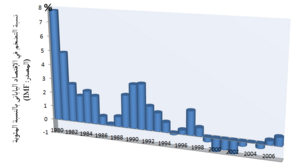
- Image via Wikipedia
Like many members of Japan’s middle class, Masato Y. enjoyed a level of affluence two decades ago that was the envy of the world.
Masato, a small-business owner, bought a $500,000 condominium, vacationed in Hawaii and drove a late-model Mercedes.
But his living standards slowly crumbled along with Japan’s overall economy. First, he was forced to reduce trips abroad and then eliminate them. Then he traded the Mercedes for a cheaper domestic model. Last year, he sold his condo — for a third of what he paid for it, and for less than what he still owed on the mortgage he took out 17 years ago.
“Japan used to be so flashy and upbeat, but now everyone must live in a dark and subdued way,” said Masato, 49, who asked that his full name not be used because he still cannot repay the $110,000 that he owes on the mortgage.
Few nations in recent history have seen such a striking reversal of economic fortune as Japan. The original Asian success story, Japan rode one of the great speculative stock and property bubbles of all time in the 1980s to become the first Asian country to challenge the long dominance of the West.
But the bubbles popped in the late 1980s and early 1990s, and Japan fell into a slow but relentless decline that neither enormous budget deficits nor a flood of easy money has reversed. For nearly a generation now, the nation has been trapped in low growth and a corrosive downward spiral of prices, known as deflation, in the process shriveling from an economic Godzilla to little more than an afterthought in the global economy.
Now, as the United States and other Western nations struggle to recover from a debt and property bubble of their own, a growing number of economists are pointing to Japan as a dark vision of the future. Even as the Federal Reserve chairman, Ben S. Bernanke, prepares a fresh round of unconventional measures to stimulate the economy, there are growing fears that the United States and many European economies could face a prolonged period of slow growth or even, in the worst case, deflation, something not seen on a sustained basis outside Japan since the Great Depression.
Many economists remain confident that the United States will avoid the stagnation of Japan, largely because of the greater responsiveness of the American political system and Americans’ greater tolerance for capitalism’s creative destruction. Japanese leaders at first denied the severity of their nation’s problems and then spent heavily on job-creating public works projects that only postponed painful but necessary structural changes, economists say.
“We’re not Japan,” said Robert E. Hall, a professor of economics at Stanford. “In America, the bet is still that we will somehow find ways to get people spending and investing again.”
Still, as political pressure builds to reduce federal spending and budget deficits, other economists are now warning of “Japanification” — of falling into the same deflationary trap of collapsed demand that occurs when consumers refuse to consume, corporations hold back on investments and banks sit on cash. It becomes a vicious, self-reinforcing cycle: as prices fall further and jobs disappear, consumers tighten their purse strings even more and companies cut back on spending and delay expansion plans.
“The U.S., the U.K., Spain, Ireland, they all are going through what Japan went through a decade or so ago,” said Richard Koo, chief economist at Nomura Securities who recently wrote a book about Japan’s lessons for the world. “Millions of individuals and companies see their balance sheets going underwater, so they are using their cash to pay down debt instead of borrowing and spending.”








